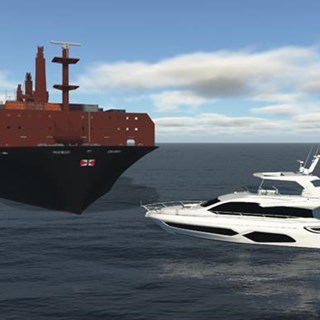
10 June 2025
For decades, submarine battery design has followed a well-trodden path: heavy lead-acid cells housed deep inside the pressure hull, taking up valuable internal volume and demanding significant upkeep. It's a familiar solution, but one that is increasingly at odds with modern operational demands, safety expectations, and supportability goals.
Today, advances in pressure-tolerant lithium-sulphur battery technology open up a radically different approach - one that allows the main battery to be moved outside the pressure hull. This is not a theoretical concept. It's a practical, validated solution, and it brings with it a set of transformational benefits to any submarine platform - whether you're designing new or upgrading existing.
If you’re a customer looking at acquiring or upgrading a conventional diesel-electric submarine, let me be absolutely clear: putting the main battery outside the pressure hull is no longer a theoretical curiosity. It’s a practical, validated concept that offers transformational benefits to platform performance, safety, supportability and ultimately, capability.
Let’s start with the simplest benefit to grasp - space. In BMT’s WYVERN concept design, removing the traditional lead acid battery tanks freed up nearly 52 cubic metres of internal space. That’s almost 9% of the pressure hull, and a 32% increase in available ‘payload’ volume - space that can now be used for what matters to you: more weapons, additional sensors, improved crew accommodation, or extended mission endurance systems like LOX tanks.
This isn’t just about comfort or convenience - this is capability you can deliver today, and adapt for tomorrow.
Weight savings with real impact
Lead acid batteries are heavy - our baseline platform carried 86 tonnes of them. With the external lithium-sulphur modules being neutrally buoyant in seawater, and with careful ballast redistribution, we managed to shed significant weight and reinvest it into capability. For WYVERN, we increased the pressure hull thickness to push the deep diving depth from 210m to over 310m - a 48% increase - all without compromising stability.
This means you can either stretch platform endurance, improve survivability, or add further mission systems. You get to choose.
Fire is the number one recorded cause of fatalities in conventional submarines, often made worse by the confined atmosphere. Hydrogen venting and thermal runaway risks from internal batteries are a serious concern. But the external battery modules we’ve analysed are fully seawater immersed, completely isolated from crew compartments, and resistant to combustion.
Even better, the lithium-sulphur chemistry selected shows dramatically improved thermal stability and resistance to abuse. In nail penetration tests, they remained safely operable, something that cannot be said for many lithium-ion cells currently in service.
As a customer, this means reduced risk, improved crew survivability, and the potential to use more energetic chemistries without compromising safety.
Submarine availability is one of the most crucial - but often underappreciated - metrics in naval operations. Lead acid battery replacement is one of the most time-consuming and manpower-intensive tasks in the entire upkeep cycle, taking up to 16 weeks and over 1200 man hours on large platforms. It often dictates the entire refit schedule.
With external batteries, replacement is simple, rapid and non-intrusive. Modular racks can be accessed dockside through removable GRP panels, and changed by hand, no cranes or confined internal routes required. More importantly, other maintenance work can carry on in parallel.
The result? Shorter refits, more operational days, and more flexibility in fleet planning. For large SSKs, we projected a 6.7% relative increase in platform availability over life, real world time your asset is at sea, not in dock.
The natural concern when presenting any novel concept is integration. But here, we’ve done the legwork. In the WYVERN case study, we engineered a complete electrical architecture, validated fault current levels (which remained comparable to lead acid), and demonstrated how even conservative protection arrangements could be achieved with commercial off-the-shelf equipment.
We accounted for underwater shock, electromagnetic signatures, and cooling, all addressed and often improved upon due to the unique benefits of seawater immersion. There’s no need for dedicated cooling or ventilation systems, which further simplifies the design and reduces cost.
Even if you’re not planning a full platform redesign, external batteries can be added retrospectively to increase capacity, provide an independent electrical supply, or compensate for degraded performance in older battery sets. They’re modular, scalable, and can be integrated around existing hull structures, particularly in double or partial double hull configurations.
In short: whether you’re buying new or upgrading existing, this technology offers you choice, flexibility and capability growth.
This is not a gimmick. It’s a thoroughly validated concept, grounded in engineering analysis and naval architecture. It’s an evolution born from unmanned systems, matured through collaboration with industry partners, and now ready to bring practical, high-value benefits to modern submarine customers.
To anyone procuring the next generation of SSKs: the question is no longer if external battery solutions can work. It’s how much you’re willing to gain by adopting them.

N/A
In a world where complexity is the norm and certainty is rare, adaptability isn’t a luxury, it’s a necessity. And when we combine it with empathy, structure, and a commitment to quality, we create programmes that deliver real, lasting value.

N/A
In a world where complexity is the norm and certainty is rare, adaptability isn’t a luxury, it’s a necessity. And when we combine it with empathy, structure, and a commitment to quality, we create programmes that deliver real, lasting value.

Tim Curtis
Most transformation programmes fail—not because of poor execution, but because they never truly understood the race they were competing in. The BMT Strategy Canvas changes that.

Will Roberts
At BMT, we believe simulation is a critical enabler in overcoming these hurdles—de-risking development, accelerating innovation, and building confidence across the entire lifecycle of autonomous systems.